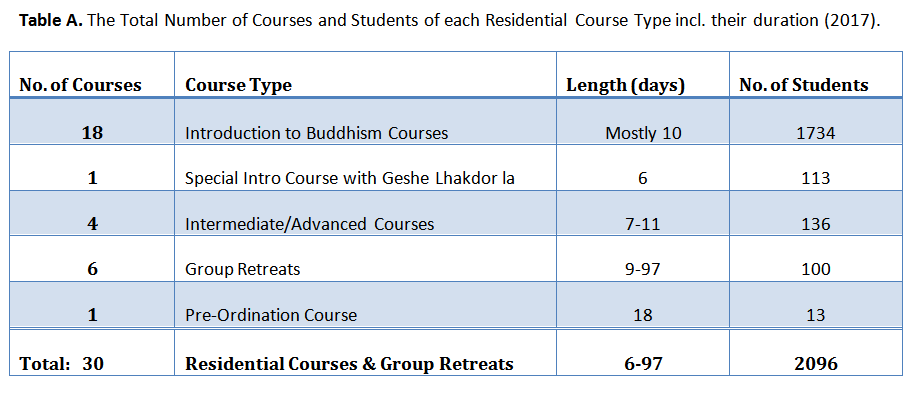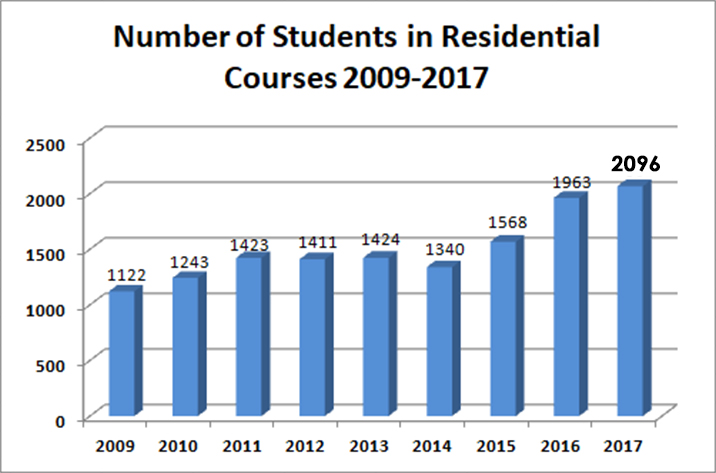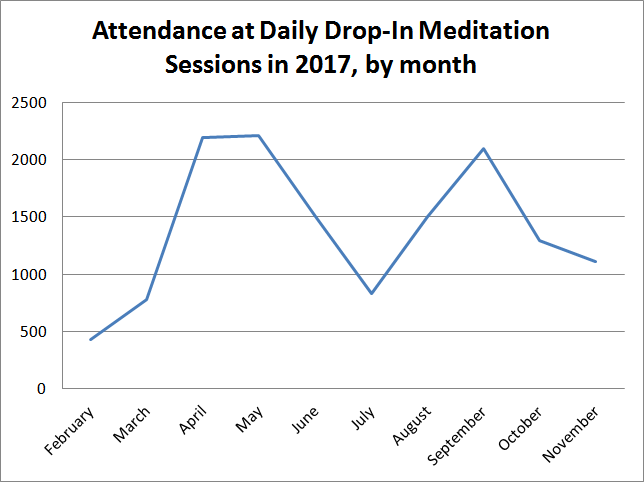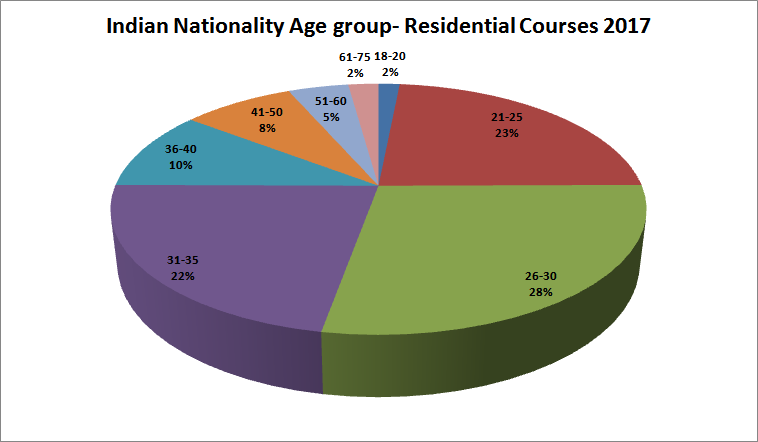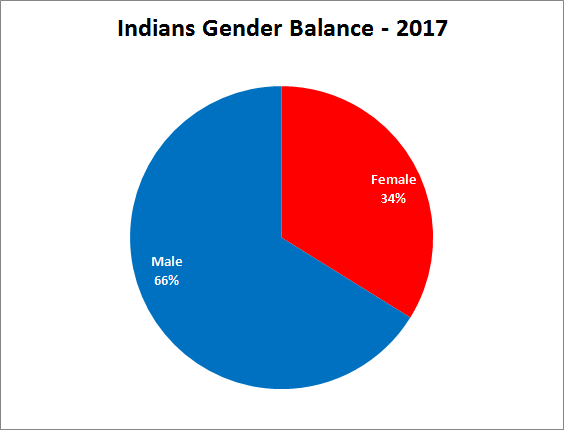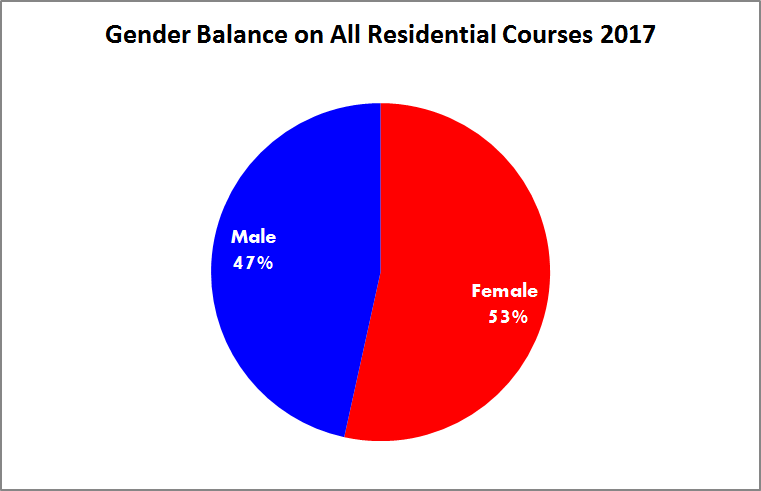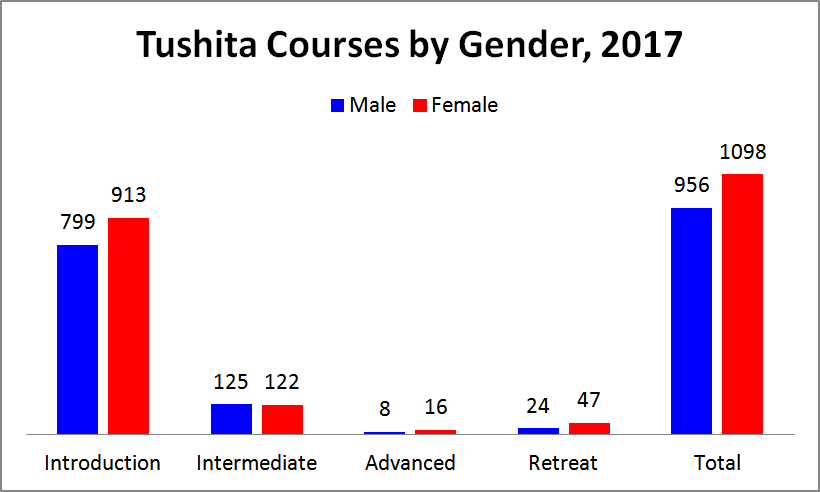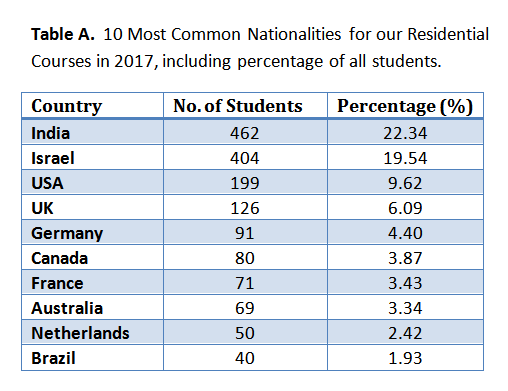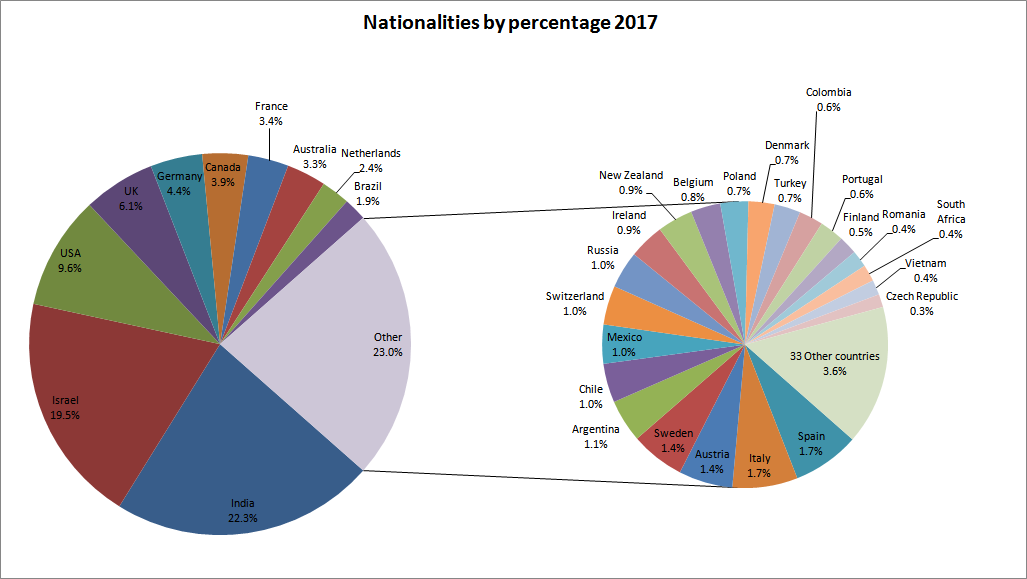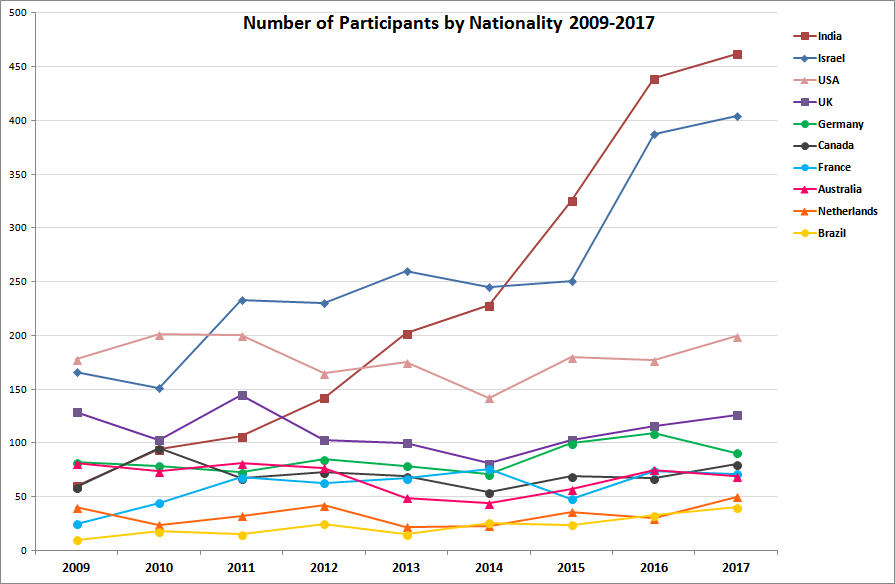- Home
- About Us
- Programs
- Being Here
- FAQs
- Resources
- News
- Links
- Support Us
Dec

Without exaggeration we can say that our 2017 season, running from February to November, was the most busy (and hopefully most beneficial) Tushita has ever seen! (See Figure 1.)
Our 2017 season started with countless blessings by our precious guru Kyabje Lama Zopa Rinpoche, giving inspiring teachings, lungs and advice during Rinpoche’s 17-day stay before the Tibetan New Year.
After such an auspicious start we hosted with much energy and enthusiasm 18 Introduction to Buddhism courses, 4 intermediate/ advanced courses and 6 group retreats. Highlights were the advanced courses with Geshe Tenzin Namdak and Geshe Kelsang Wangmo and courses & retreats with our new Resident Teacher Venerable Drolma.
In addition, we were extremely fortunate to have Dagri Rinpoche teaching a 5-day course on Shantideva’s “A Guide to the Bodhisattva’s Way of Life”, with Rinpoche promising a continuation in the coming years. Another special 6-day course was led by Geshe Lhakdor la on Atisha’s “Lamp of the Path to Enlightenment”.
All these residential courses and retreats were attended by nearly 2,100 students – a new Tushita record!!
This was boosted by our surprisingly high attendance in our February course, which has historically been very low as the season is just getting started, and there are typically very few Indians coming then due to the cold winter weather.
As per usual, most of our courses had long waiting lists and once again as in recent years our most numerous student nationality was India (see Nationality below).
We averaged a phenomenal 95 students per Introductory course in 2017!
You can see the growth progression of these popular courses over the past six years in Figure 2 below.
On top of all this we hosted our very popular daily meditation sessions and other drop-in activities. These attracted thousands of visitors again this season (more than 24, 306 in total!) – often squeezed tightly into our meditation halls and overflowing to the outside.
Our highest average monthly attendance occurred in April with 87 students per morning meditation. It is typical for attendance to drop during Monsoon in July/August, though Figure 3 shows a particularly sharp drop in July. This is due to the fact that we hosted 3 simultaneous courses/retreats which filled all of our meditation halls and prevented us from offering morning meditations during that time.
In addition to these regular offerings, we had the tremendous fortune to host His Eminence Ling Rinpoche’s two visits to give His first official teaching at Tushita on “The Eight Verses of Mind Training” and to convey His first initiation at Tushita of Long Life Amitayus. Both events were extremely popular, and we pray that many more will follow.
Further highlights were teachings and initiation by Yangten Rinpoche, Serkong Tsenshab Rinpoche, Khadro Rinpoche, Jetzunma Tenzin Palmo, and Gen Gyatso la.
But who are these people who come on Tushita courses?
Who are our Indian Students?
Now that we have so many Indian students coming to Tushita, we have become curious to learn more about our local friends.
Age
Traditionally in India the later stages of life (after one’s children are grown) are when one prioritizes spiritual practices and development. Thus it is fascinating to see in the figure above that 73% of our Indian students are between the ages of 21 and 35. This shift of interest to younger generations is remarkable given the traditional context, and one which we celebrate. The sooner we begin to understand the nature of our mind and reality, the sooner we can bring greater peace and happiness into our lives and those around us!
Gender
Two thirds of our Indian students this year were male. We are curious to see if this ratio changes in the coming years or if it will stay as consistent as the gender balance of our overall population of students.
The above figure shows that among the top ten nationalities of our courses in 2017, India is the only one with a majority male representation. Netherlands has an even greater disparity in the opposite direction.
How old are the students on Tushita’s courses (2017)?
In 2017 we had our greatest age range of students in a single year since we began collecting such data in 2009. We had our oldest student yet at 83 years. With our youngest student this year at 18 this is a span of 65 years!
As you can see from this graph below, there’s a predominance of students in their 20’s on our Introduction to Buddhism courses. However it also shows good representation across age groups. The ring chart below shows that 59% of students are aged 18 – 30, 27% aged 31 – 40, and 14% are over 40. What is remarkable is that these percentages remain almost the exact same year to year – typically with a single percentage variation.
While the majority of students in Introductory courses are under 30, in our Intermediate courses there is a much more balanced mix of ages. We don’t have the same predominance of students in their twenties in our Intermediate courses that we do in our Introductory courses. This is evidenced in the graph below showing the age range of Intermediate course students (green) against that of the Introductory course students (red).
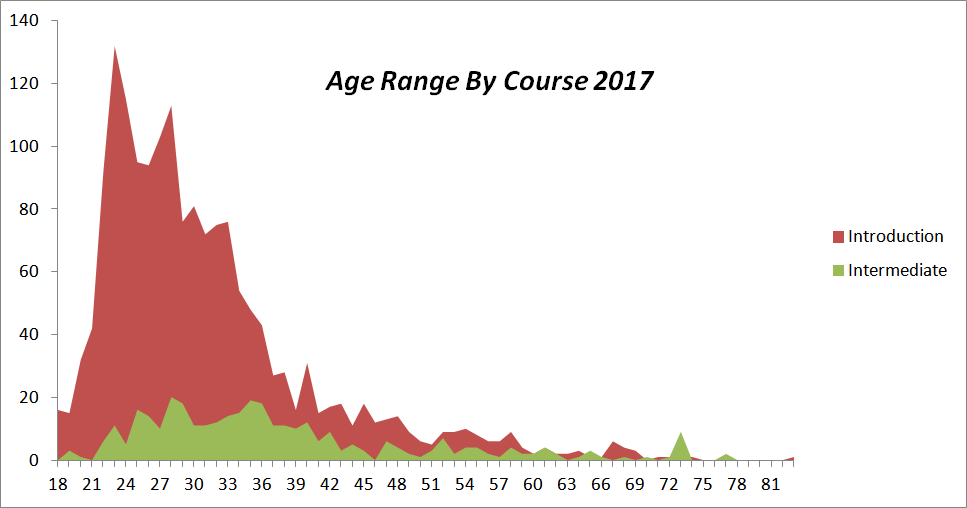
Figure 2. Spectrum of student ages in Introduction courses overlaid by those of Intermediate course students in 2017.
How many Men & Women take part in our courses (2017)?
Over the 9 years we’ve been studying our records, the gender balance of students has remained very stable, with always 5-10% more women than men taking part. Over the years the percentage of men has increased from 42 to 47%.
The graph below depicts the breakdown of gender by course types in 2017. While there are typically more females than males in all of our courses, this year we actually had slightly more males than females in our Intermediate courses.
Where are Tushita’s Students from (2017)?
Since we began collecting data in 2009, we’ve had students in our residential courses from 96 different countries! In 2017 we were thrilled to welcome students from Tunisia and Albania for the first time.
In Table A you can see a list of the top ten nationalities represented in our residential courses in 2017. (Figure 4 below shows these countries highlighted on a world map.)
If you would like to see the full list of 96 countries, please click here. See if your country is represented. If not: come, we need you!
Spain has held a place in our Top 10 since we began keeping records in 2009. This year, however, they dropped out of the Top 10 for the first time and have been replaced with Brazil who broke through last year replacing the Netherlands. Not one to be outdone for long, the Netherlands came back with boosted numbers this year and together with Brazil they overtook Spain in numbers.
Figure 2 (below) gives historical perspective by showing national trends. One of the most significant changes we’ve noticed over the past 9 years is the shift in national patterns of participation, primarily – The Rise of India!!!
In 2011 Israel took over the top position from the USA and held that position until 2015 when we saw a surge in Indian participation.
Participation among Indian citizens has increased 770% in 9 years – from 60 students in 2009 to 462 students in 2017!
We rejoice – returning Buddha Dharma to the Motherland!
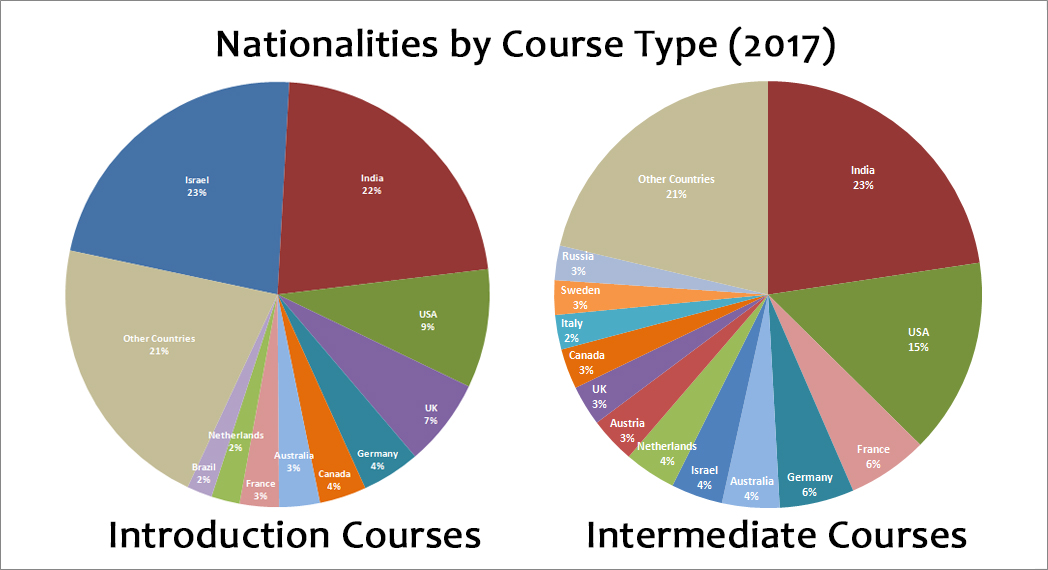
Figure 3. A comparison of nationalities represented in both Introductory and Intermediate/Advanced courses in 2017.
As the above figure reveals, the same proportion of Indians who participated in our Introductory courses go on to participate in our Intermediate and Advanced courses. Conversely, our Israeli population – which is so consistently high in our Introductory courses – drops dramatically from 23% to just 4% in our further courses.
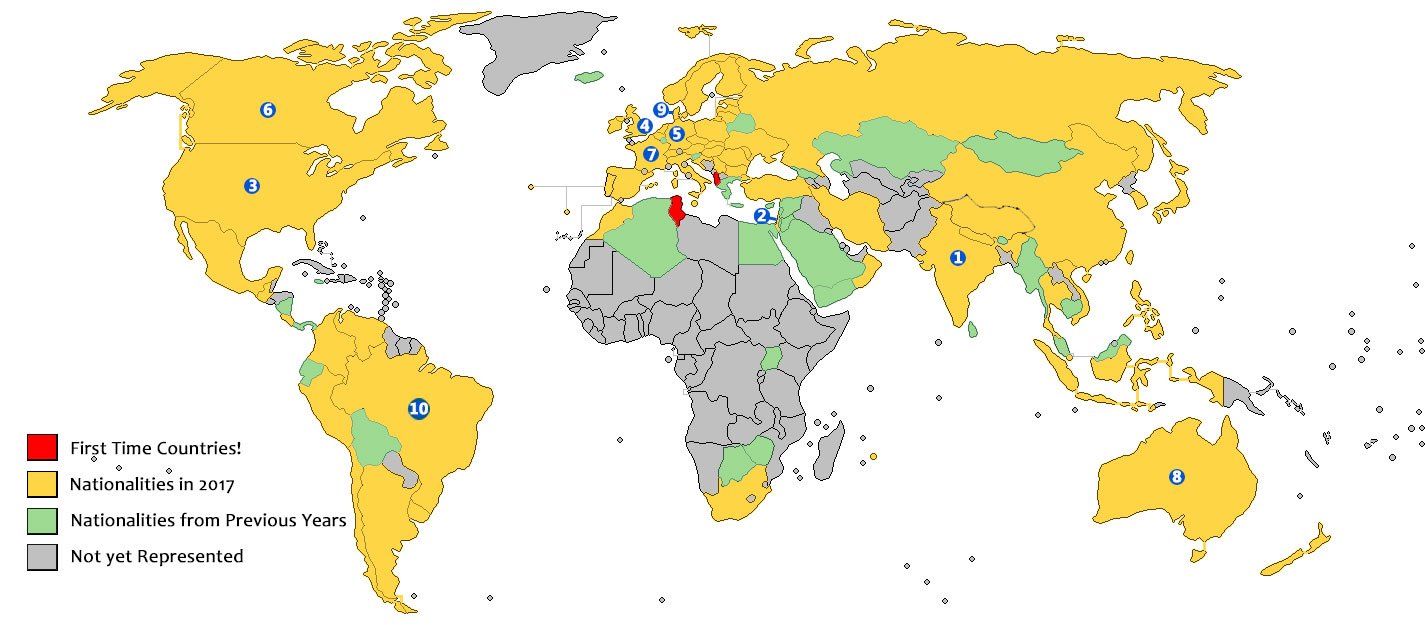
Figure 4. World Map highlighting countries from which we had students for the first time this year (red), all countries represented in 2017 (yellow), previously represented nationalities who were not present this year (green), and countries from which we have not yet had a student (grey). Numbers indicate this year’s Top Ten Nationalities represented. If your country is in Grey, please come! Tell us and we will give you special Momos!
Click here to see the full list of countries in 2017!
#
Native Country of
Residential Students2017
% 2017
1
India
462
22.34
2
Israel
404
19.54
3
USA
199
9.62
4
UK
126
6.09
5
Germany
91
4.40
6
Canada
80
3.87
7
France
71
3.43
8
Australia
69
3.34
9
Netherlands
50
2.42
10
Brazil
40
1.93
11
Spain
36
1.74
12
Italy
35
1.69
13
Sweden
29
1.40
14
Austria
29
1.40
15
Argentina
23
1.11
16
Mexico
21
1.02
17
Switzerland
21
1.02
18
Chile
21
1.02
19
Russia
20
0.97
20
Ireland
19
0.92
21
New Zealand
19
0.92
22
Belgium
16
0.77
23
Poland
15
0.73
24
Denmark
14
0.68
25
Turkey
14
0.68
26
Colombia
13
0.63
27
Portugal
13
0.63
28
Finland
10
0.48
29
South Africa
9
0.44
30
Romania
9
0.44
31
Vietnam
8
0.39
32
Czech Republic
7
0.34
33
South Korea
6
0.29
34
Japan
6
0.29
35
Singapore
6
0.29
36
Norway
5
0.24
37
China
4
0.19
38
Bulgaria
4
0.19
39
Mauritius
4
0.19
40
Peru
4
0.19
41
Tibet
3
0.15
42
Serbia
3
0.15
43
Ukraine
2
0.10
44
Hungary
2
0.10
45
Lithuania
2
0.10
46
Latvia
2
0.10
47
Croatia
2
0.10
48
Uruguay
2
0.10
49
Guatemala
2
0.10
50
Taiwan
1
0.05
51
Estonia
1
0.05
52
Slovakia
1
0.05
53
Thailand
1
0.05
54
Indonesia
1
0.05
55
Iran
1
0.05
56
Malta
1
0.05
57
Venezuela
1
0.05
58
Costa Rica
1
0.05
59
Philippines
1
0.05
60
Nepal
1
0.05
61
Morocco
1
0.05
62
Oman
1
0.05
63
Moldova
1
0.05
64
Tunisia
1
0.05
65
Albania
1
0.05
Total
2068
100.00
#
Native Country of
Residential Students2009
2010
2011
2012
2013
2014
2015
2016
2017
2009-2017
% From 2009-2017
1
Israel
166
151
233
230
260
245
251
387
404
2327
17.16
2
India
60
94
106
142
202
228
325
439
462
2058
15.18
3
USA
178
201
200
165
175
142
180
177
199
1617
11.92
4
UK
129
103
145
103
100
81
103
116
126
1006
7.42
5
Germany
82
79
73
85
79
71
100
109
91
769
5.67
6
Canada
59
95
67
73
69
54
69
67
80
633
4.67
7
Australia
81
74
81
77
49
44
57
75
69
607
4.48
8
France
25
44
68
63
67
76
48
74
71
536
3.95
9
Spain
25
35
33
35
38
27
35
38
36
302
2.23
10
Netherlands
40
24
32
42
22
23
36
30
50
299
2.20
11
Sweden
13
25
26
35
34
18
16
29
29
225
1.66
12
Brazil
10
18
15
25
15
26
24
33
40
206
1.52
13
Austria
12
18
27
31
16
10
25
19
29
187
1.38
14
Italy
14
16
14
17
22
13
23
32
35
186
1.37
15
Mexico
17
21
19
24
14
10
9
23
21
158
1.17
16
Switzerland
15
26
14
28
15
15
8
13
21
155
1.14
17
Russia
8
2
7
9
26
26
26
27
20
151
1.11
18
Ireland
19
16
22
16
14
15
10
20
19
151
1.11
19
Argentina
7
8
14
17
14
19
20
25
23
147
1.08
20
New Zealand
18
20
12
6
11
8
11
16
19
121
0.89
21
Belgium
11
9
9
17
9
16
18
13
16
118
0.87
22
Poland
6
9
9
9
10
19
11
18
15
106
0.78
23
Chile
1
10
12
3
12
8
13
21
21
101
0.74
24
Denmark
15
10
16
13
10
8
7
6
14
99
0.73
25
Finland
14
6
18
9
11
6
9
14
10
97
0.72
26
South Korea
9
7
12
20
12
6
3
9
6
84
0.62
27
Colombia
2
8
7
7
7
13
13
13
13
83
0.61
28
South Africa
9
4
5
7
12
9
14
14
9
83
0.61
29
Portugal
6
1
15
9
15
3
6
11
13
79
0.58
30
Japan
11
6
11
8
11
4
5
4
6
66
0.49
31
Turkey
3
6
5
5
2
6
5
6
14
52
0.38
32
Czech Republic
4
2
7
6
5
7
3
3
7
44
0.32
33
Singapore
2
10
7
7
1
1
7
1
6
42
0.31
34
Taiwan
4
16
1
3
7
3
6
0
1
41
0.30
35
Slovenia
5
1
2
8
4
9
9
3
0
41
0.30
36
Romania
1
3
2
2
5
6
5
5
9
38
0.28
37
Norway
2
5
2
8
6
2
3
5
5
38
0.28
38
Ukraine
2
5
3
3
6
7
2
6
2
36
0.27
39
Hungary
2
6
2
3
4
6
3
3
2
31
0.23
40
China
1
2
3
4
5
4
4
1
4
28
0.21
41
Vietnam
6
0
1
3
3
3
0
3
8
27
0.20
42
Estonia
5
1
10
2
1
1
2
4
1
27
0.20
43
Slovakia
3
7
5
0
0
5
3
3
1
27
0.20
44
Tibet
3
5
4
0
6
1
2
1
3
25
0.18
45
Greece
5
4
1
3
1
5
3
2
0
24
0.18
46
Malaysia
1
8
1
4
0
1
3
3
0
21
0.15
47
Bulgaria
0
0
2
0
3
2
3
5
4
19
0.14
48
Lithuania
1
0
2
5
0
2
4
3
2
19
0.14
49
Thailand
0
1
5
0
2
2
6
1
1
18
0.13
50
Indonesia
0
5
10
0
0
1
1
0
1
18
0.13
51
Mauritius
0
2
1
1
1
3
1
2
4
15
0.11
52
Latvia
1
1
5
2
1
1
0
2
2
15
0.11
53
Iran
0
1
3
0
0
0
2
3
1
10
0.07
54
Peru
0
2
0
1
0
1
1
0
4
9
0.07
55
Malta
1
0
2
1
1
2
1
0
1
9
0.07
56
Croatia
0
0
0
0
0
0
1
5
2
8
0.06
57
Venezuela
1
1
1
1
0
3
0
0
1
8
0.06
58
Uruguay
0
1
0
0
1
1
0
2
2
7
0.05
59
Belarus
0
0
1
1
2
1
2
0
0
7
0.05
60
Luxembourg
4
0
1
2
0
0
0
0
0
7
0.05
61
Costa Rica
0
0
0
0
0
0
1
4
1
6
0.04
62
Philippines
0
0
1
0
0
1
2
1
1
6
0.04
63
Nepal
1
1
0
2
1
0
0
0
1
6
0.04
64
Serbia
0
0
1
0
0
0
0
1
3
5
0.04
65
Iceland
0
1
0
1
0
1
0
2
0
5
0.04
66
Ecuador
0
0
1
3
0
0
1
0
0
5
0.04
67
Guatemala
0
0
0
0
0
1
1
0
2
4
0.03
68
Morocco
0
1
0
0
1
1
0
0
1
4
0.03
69
Kazakhstan
0
0
0
0
0
0
1
3
0
4
0.03
70
Lebanon
0
0
0
1
0
0
0
3
0
4
0.03
71
Cyprus
0
3
0
0
1
0
0
0
0
4
0.03
72
Egypt
0
0
0
1
0
2
1
0
0
4
0.03
73
Oman
0
0
0
1
1
0
0
0
1
3
0.02
74
Jordan
0
0
0
0
0
1
1
1
0
3
0.02
75
Kyrgyzstan
0
0
1
1
0
0
0
1
0
3
0.02
76
Moldova
0
0
0
0
0
0
1
0
1
2
0.01
77
Sri Lanka
0
0
1
0
0
0
0
1
0
2
0.01
78
Botswana
0
0
0
0
0
1
1
0
0
2
0.01
79
Georgia
1
0
1
0
0
0
0
0
0
2
0.01
80
Jamaica
0
0
2
0
0
0
0
0
0
2
0.01
81
Mongolia
0
0
0
0
2
0
0
0
0
2
0.01
82
Bolivia
0
0
0
0
0
0
0
2
0
2
0.01
83
Tunisia
0
0
0
0
0
0
0
0
1
1
0.01
84
Albania
0
0
0
0
0
0
0
0
1
1
0.01
85
Algeria
0
0
0
0
0
1
0
0
0
1
0.01
86
Bhutan
0
1
0
0
0
0
0
0
0
1
0.01
87
Cambodia
0
0
0
0
0
1
0
0
0
1
0.01
88
Myanmar
0
0
1
0
0
0
0
0
0
1
0.01
89
Nicaragua
0
0
0
1
0
0
0
0
0
1
0.01
90
Palestine
1
0
0
0
0
0
0
0
0
1
0.01
91
Panama
0
0
1
0
0
0
0
0
0
1
0.01
92
Saudi Arabia
0
0
1
0
0
0
0
0
0
1
0.01
93
Syria
0
0
1
0
0
0
0
0
0
1
0.01
94
Uganda
0
1
0
0
0
0
0
0
0
1
0.01
95
Zimbabwe
0
0
0
0
0
1
0
0
0
1
0.01
96
Yemen
0
0
0
0
0
0
1
0
0
1
0.01
Total
1122
1243
1423
1411
1424
1340
1568
1963
2068
13562
100.00
Upcoming Events
- Building Inner Strength on July 27, 2024
- Guided Meditation on July 27, 2024 9:00 am
- Movie Day on July 29, 2024 2:00 pm
- Introduction to Buddhism on July 30, 2024
- Introduction to Buddhism on August 13, 2024
- Guru Puja on August 14, 2024 6:30 pm
- Introduction to Buddhism on August 31, 2024
- HH the Dalai Lama teaches locally! on September 6, 2024
- Introduction to Buddhism on September 17, 2024
- Less Desire, Less Pain – The Art of Satisfaction on October 5, 2024
About Tushita
Tushita is a centre for the study and practice of Buddhism from the Tibetan Mahayana tradition. We're located in Northern India, in the forested hills above the town of McLeod Ganj, Dharamsala - the seat in exile of His Holiness the 14th Dalai Lama.
Tushita aims to provide a friendly and conducive environment for people of all nationalities and backgrounds to learn about and put into practice the teachings of the Buddha. With this in mind we offer regular drop-in events and courses on introductory Buddhist philosophy and meditation, as well as intermediate level courses and group retreats for more experienced students.
Opening Hours
February to November
Monday - Saturday
9:30 - 11:30am
a break for lunch and then...
12:30 - 4:00pm
Closed Sundays


